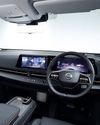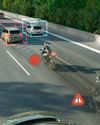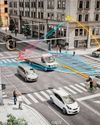Globally, more than one million vehicle-related fatal accidents take place every year, along with more than 20 mn crash-related injuries. Costs for this mayhem are estimated to be more than ` 200 lakh crore – a sum that’s hard to even comprehend for most people. Of the many initiatives being undertaken by car manufacturers to wards trying to enhance safety, and reduce the number of accidents that happen worldwide every year, one important initiative is increasing night-time visibility for drivers. Automotive lighting systems have already witnessed significant advancements over the last two to three decades, and further development continues relentlessly. We take a look at some cutting-edge developments in this space.

LIGHTING EVOLUTION
Automotive lighting started with carbide acetylene lamps in the late-1880s, moving to full electric lighting in the early-1900s. Sealed beam headlamps (the kind used today), with a lighting filament, parabolic reflector and a lens sealed together came in the late-1930s, while the much brighter halogen headlamps started appearing on some European cars by the early-1960s. The next big move came about in the early-2000s, when high-intensity discharge (HID) Xenon lamps were introduced on some high-end cars. Xenon/HID lamps produced light by creating an electrical arc between two metal electrodes, through an inert gas, inside a glass bulb. Much more efficient than traditional bulbs, HIDs created brighter, more intense ‘white’ light while consuming relatively lower amount of power. These were also physically smaller, providing more design flexibility to car manufacturers in terms of shaping a car’s headlamps. However, there were issues with HID lamps ‘dazzling’ oncoming traffic due to their intense light getting ‘scattered’ by traditional light assemblies, and manufacturers started looking for better solutions.
One solution, which is now finding widespread use not just in higher-end cars but also on relatively cheaper vehicles, is light-emitting diodes (LEDs), with the Audi A8 being the first production car to have LED daytime running lights (DRLs). While LEDs were initially used only in DRLs, costs have come down over the last five years and many OEMs are now increasingly opting for full-LED illumination on their cars. In fact, the 2007 Audi R8 was the first production car to use full LED illumination, with the Mercedes-Benz CLS following suit.
This story is from the March 2017 edition of Auto Tech Review.
Start your 7-day Magzter GOLD free trial to access thousands of curated premium stories, and 8,500+ magazines and newspapers.
Already a subscriber ? Sign In
This story is from the March 2017 edition of Auto Tech Review.
Start your 7-day Magzter GOLD free trial to access thousands of curated premium stories, and 8,500+ magazines and newspapers.
Already a subscriber? Sign In

Sound Generation For Enhanced Road Safety
With an ever-increasing number of fully electric and hybrid vehicles entering the market, we are witnessing a change in the acoustic experience in and around the car. The silent nature of the electric powertrain means that other road users miss the familiar acoustic cues that warn them of an approaching vehicle. To remedy this situation, Harman is working on various noise management solutions.

OBJECTIVE ASSESSMENT OF THE SAFETY CONTRIBUTION OF TODAY'S AUTOMOTIVE HEADLAMPS
Good lighting makes a major contribution to road safety. In 2011, the International Commission on Illumination (CIE) presented an evaluation system for headlamps that can objectively assess the quality of illumination and glare limitation. New light sources like LEDs and lighting functions (glare-free high beam, partial high beam) have been available for several years, so that an extension of the proven CIE method is necessary, which takes into account, among other things, changed switch-on and service lives of new lighting functions and represents a generally understandable evaluation system. An evaluation system presented in the following by the Technische Uni versität Darmstadt, which was developed by an encompassing expert commission, is intended to provide representative data and enable an objective evaluation of headlamp performance.

RAPIDO RE-INNOVATES TO CATER TO POST COVID-19 LAST MILE CONNECTIVITY
The rapid pace of urbanisation in the country has witnessed cities expanding and subsuming surrounding villages and smaller towns, evolving into Tier II and III cities.

FUNCTIONAL SAFETY STANDARDS TOP PRIORITY FOR FUTURE AUTOMOTIVE DEPLOYMENT
Increasing levels of electronic content in vehicles result in a large amount of software that is required to run the scenes behind the mechanical aspects of a vehicle. Electronic systems in automobiles are part of every section, from the powertrain to comfort and convenience systems as well as all types of safety equipment. This makes electronics and the software running these systems a critical part of the equation for future mobility solutions. In addition, putting standards in place to measure methods of developing, testing and functioning of such electronic systems also becomes highly relevant.

“BYD'S EV STRATEGY TO ENCOMPASS MOST FORMS OF TRANSPORTATION NEEDS IN INDIA”
The country’s electric vehicle (EV) ecosystem is grappling with a plethora of challenges even as it is striving to wriggle itself out of the ‘nascent stage’ tag. In an exclusive chat with Auto Tech Review, Zhang Jie Ketsu, Executive Director, BYD India shares his perspective on the current EV scenario and how the company intends to progress faster in the Indian automotive industry

SAFETY IN ELECTRIC AND AUTONOMOUS CARS – SIMULATION OF COMPLEX CRASH SCENARIOS
Electric and autonomous vehicles allow for novel seating arrangements and packaging strategies, presenting new safety challenges. Physical crash testing must be supplemented with virtual simulation to ensure vehicle safety on shorter development cycles. With its Simcenter Madymo MBS software, Siemens provides improved runtimes and the Active Human model, enabling accurate and rapid occupant safety analysis in complex crash scenarios.

KIA SONET – A MIGHTY OFFERING IN THE COMPACT SUV SEGMENT
It wouldn't be wrong to say that Kia Motors India has taken the Indian market by storm in less than 12 months of its presence in the market.

NISSAN'S NEW DIRECTION: ARIYA ALL-ELECTRIC
Marking a key milestone in Nissan’s transformation strategy, Ariya ticks a lot of boxes highlighting the strengths of the global automotive giant.

BETTER SAFETY WITH EMERGENCY BRAKE ASSIST FOR MOTORCYCLES
Rear-end collisions with a slower vehicle suddenly cutting into the lane and intersection accidents with cross-traffic are among the most frequent motorcycle accident types. Continental is now developing an emergency brake assist, which detects an imminent collision with a vehicle ahead or with an obstacle, warns the rider and supports him during braking

ADAS WILL SERVE AS CATALYST FOR IMPROVED VEHICLE SAFETY
The automotive industry across the globe is increasingly focussing on safety.